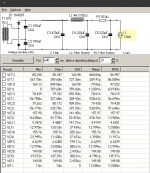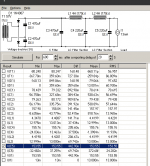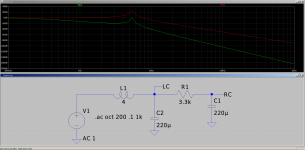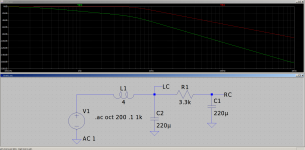Merry Xmas!
ANyone has built the Aikido 6SN7 with a CLCLC power supply??
Any comments are appreciated??
Thanks!
ANyone has built the Aikido 6SN7 with a CLCLC power supply??
Any comments are appreciated??
Thanks!
Why would they want to.
An inductor only works as a 'choke' at the rectified DC frequency otherwise it is merely an expensive resistor.
The way they work best is; Rectifier into a tank capacitor feeding a choke and into a final capacitor.
Any ripple caused by current drain from the supplied circuit is inverted within the choke inductance and pumped back into the second capacitor. If there is very little current drawn, (like in a pre amp stage), a choke is not needed as a resistor is sufficient. Power stages bennefit from a choke but then again, only the one.
To place yet another choke and capacitor is futile but people like to do it thinking it has "an improved sound" to help them get over the financial costs involved.
It is a mind over matter folly.
Many older designs when capacitors were very expensive over say 8uF, a choke had to be employed but now with large value high voltage capacitors available, it is no longer a requirement.
An inductor only works as a 'choke' at the rectified DC frequency otherwise it is merely an expensive resistor.
The way they work best is; Rectifier into a tank capacitor feeding a choke and into a final capacitor.
Any ripple caused by current drain from the supplied circuit is inverted within the choke inductance and pumped back into the second capacitor. If there is very little current drawn, (like in a pre amp stage), a choke is not needed as a resistor is sufficient. Power stages bennefit from a choke but then again, only the one.
To place yet another choke and capacitor is futile but people like to do it thinking it has "an improved sound" to help them get over the financial costs involved.
It is a mind over matter folly.
Many older designs when capacitors were very expensive over say 8uF, a choke had to be employed but now with large value high voltage capacitors available, it is no longer a requirement.
Attachments
I have never understood the use of chokes in preamp power supplies. You can achieve incredibly low ripple and noise with a simple, cheap CRCRCRC.
Cheer
Ian
Cheer
Ian
Actually, multiple chokes will probably be a liability. Each CLC filter section has a resonance. Put a few in series and the resonances interact with each other in crazy ways. Perhaps a CLCRCRC would be OK. But I think ruffrecords is correct. A string of CRC filters can suppress ripple into oblivion country, with predictable behavior (resistors don't have interwinding capacitance or other faults inherent in inductors).
I think the reason for using an actively regulated PSU is to reduce the supply impedance, which should tighten up the bass and prevent the possibility of motorboating (subsonic coupling between gain sections through the plate supply).
I think the reason for using an actively regulated PSU is to reduce the supply impedance, which should tighten up the bass and prevent the possibility of motorboating (subsonic coupling between gain sections through the plate supply).
P.S. I am not making any claims about desirability especially since I have a lot of learning to do especially with regard to choice of time constants and stability but the much greater hum attenuation with less voltage drop would certainly be tempting. The above is intended for phono stage.
I do not understand the relevance of the 57V secondary?P.S. I am not making any claims about desirability especially since I have a lot of learning to do especially with regard to choice of time constants and stability but the much greater hum attenuation with less voltage drop would certainly be tempting. The above is intended for phono stage.
Cheers
Ian
CLCLC is the power supply for phono not preamp circuits! it is ok to use one choke, probably in CLCRC, small schoke with thin wire (resistances of the choke from cca 100-500R) will do the job. better though and cheaper is to use simple mosfet regulator for preamps but this is other threadMerry Xmas!
ANyone has built the Aikido 6SN7 with a CLCLC power supply??
Any comments are appreciated??
Thanks!
That is the transformer I have on hand. The example was some simulations I am doing for phono preamp.I do not understand the relevance of the 57V secondary?
Cheers
Ian
PSUD2 does not show impedance bumps and possible resonances in the power supply. There is more to a power supply than simple ripple rejection.
For instance, if the ripple rejection is -95dB at 120Hz, we'd say that PSU is really really quiet.
But what if the power supply noise suppression way down at 1Hz is only -5dB, or even worse? Yes, that is a possibility with a passive supply, especially if you don't decouple the high gain input stage of a phono preamp effectively enough, This becomes critical if you're using a pentode or cascode input stage.
Some combinations of L and C and series R will create a low frequency resonance that can cause problems. It is sometimes necessary to add series resistance to the LC network to damp that resonance. Of course that defeats the purpose of using a choke there (lower DCR compared to a series resistor to achieve the same time constant). In some cases an RC with a resistor the same value as the DCR of the choke can prove to be superior.
A series voltage regulator will use negative feedback to reduce the supply impedance at subsonic frequencies compared to a passive filtered supply. No motorboating that way.
I'm using a passive filtered PSU in a phono preamp I built recently. It's quiet as far as hum goes, but my first try had a problem with intermittent motorboating. The cure was to make the first stage RC decoupling time constant really really long to keep that stage stable at subsonic frequencies. I ended up with R = 43k and C = 33uF. That is one really long time constant.
I'm too lazy to put a regulated B+ in, but I should. It would very likely improve things.
For instance, if the ripple rejection is -95dB at 120Hz, we'd say that PSU is really really quiet.
But what if the power supply noise suppression way down at 1Hz is only -5dB, or even worse? Yes, that is a possibility with a passive supply, especially if you don't decouple the high gain input stage of a phono preamp effectively enough, This becomes critical if you're using a pentode or cascode input stage.
Some combinations of L and C and series R will create a low frequency resonance that can cause problems. It is sometimes necessary to add series resistance to the LC network to damp that resonance. Of course that defeats the purpose of using a choke there (lower DCR compared to a series resistor to achieve the same time constant). In some cases an RC with a resistor the same value as the DCR of the choke can prove to be superior.
A series voltage regulator will use negative feedback to reduce the supply impedance at subsonic frequencies compared to a passive filtered supply. No motorboating that way.
I'm using a passive filtered PSU in a phono preamp I built recently. It's quiet as far as hum goes, but my first try had a problem with intermittent motorboating. The cure was to make the first stage RC decoupling time constant really really long to keep that stage stable at subsonic frequencies. I ended up with R = 43k and C = 33uF. That is one really long time constant.
I'm too lazy to put a regulated B+ in, but I should. It would very likely improve things.
Yes I am always on the lookout for information on such details. When you talk about the long time constant of the first stage decoupling are you talking about the decoupling at the input stage of the preamp? Do you try to use different time constants for each amplifier stage? When it comes to the actual filter stages do you put the longest time constant closest to the transformer or closer to the load?PSUD2 does not show impedance bumps and possible resonances in the power supply. There is more to a power supply than simple ripple rejection.
For instance, if the ripple rejection is -95dB at 120Hz, we'd say that PSU is really really quiet.
But what if the power supply noise suppression way down at 1Hz is only -5dB, or even worse? Yes, that is a possibility with a passive supply, especially if you don't decouple the high gain input stage of a phono preamp effectively enough, This becomes critical if you're using a pentode or cascode input stage.
Some combinations of L and C and series R will create a low frequency resonance that can cause problems. It is sometimes necessary to add series resistance to the LC network to damp that resonance. Of course that defeats the purpose of using a choke there (lower DCR compared to a series resistor to achieve the same time constant). In some cases an RC with a resistor the same value as the DCR of the choke can prove to be superior.
A series voltage regulator will use negative feedback to reduce the supply impedance at subsonic frequencies compared to a passive filtered supply. No motorboating that way.
I'm using a passive filtered PSU in a phono preamp I built recently. It's quiet as far as hum goes, but my first try had a problem with intermittent motorboating. The cure was to make the first stage RC decoupling time constant really really long to keep that stage stable at subsonic frequencies. I ended up with R = 43k and C = 33uF. That is one really long time constant.
I'm too lazy to put a regulated B+ in, but I should. It would very likely improve things.
In this case I was forced to put the longest time constant to the audio input stage, so at the end of the CRCRCRCRC chain.
I've attached a schematic of the RIAA phono preamp and its PSU. It's a very simple circuit, really elementary. I built it on one of Merlnb's Compact Phono PCBs. The raw B+ DC supply is on a GlassWare PCB, and the heater DC regulator is on a Pete Millett board.
R18 and C10 form the decooupling network for the power supply to the first (input) stage.
Originally R18 was a smaller value (I think it was 10k to start with), which brought on the motorboating issue. Increasing R18 to 43k fixed that problem.

I've attached a schematic of the RIAA phono preamp and its PSU. It's a very simple circuit, really elementary. I built it on one of Merlnb's Compact Phono PCBs. The raw B+ DC supply is on a GlassWare PCB, and the heater DC regulator is on a Pete Millett board.
R18 and C10 form the decooupling network for the power supply to the first (input) stage.
Originally R18 was a smaller value (I think it was 10k to start with), which brought on the motorboating issue. Increasing R18 to 43k fixed that problem.
Thanks. Much appreciated.In this case I was forced to put the longest time constant to the audio input stage, so at the end of the CRCRCRCRC chain.
I've attached a schematic of the RIAA phono preamp and its PSU. It's a very simple circuit, really elementary. I built it on one of Merlnb's Compact Phono PCBs. The raw B+ DC supply is on a GlassWare PCB, and the heater DC regulator is on a Pete Millett board.
R18 and C10 form the decooupling network for the power supply to the first (input) stage.
Originally R18 was a smaller value (I think it was 10k to start with), which brought on the motorboating issue. Increasing R18 to 43k fixed that problem.
View attachment 1009235
I have built a number of Aikido 6SN7 line stages that were point to point construction. I have never used a CLCLC power supply on any linestage I have built. Mine luckily have been noise free including the last Aikido I built which was a 6AU6/5687 linestage. It is completely quiet. Is it necessary to go to that extreme and expense?Merry Xmas!
ANyone has built the Aikido 6SN7 with a CLCLC power supply??
Any comments are appreciated??
Thanks!
You lost me. Surely phono IS a preamp.CLCLC is the power supply for phono not preamp circuits! i
Cheers
Ian
"preamp" is a line preamp,like aikido is, "phono" is phono 🙂
CLCLC is overkill for line stage, but it is ok for phono
CLCLC is overkill for line stage, but it is ok for phono
Just wondering about using LTspice to visualize filter design options. The issue of resonances makes sense so was thinking about how to deal with them So I ran this inductor
https://edcorusa.com/collections/power-chokes/products/cxse5-5k-4h-50ma-choke
Through setting its series resistance to zero and then the actual 170 ohm value with the former showing a resonant peak which the series resistance damps out. I set a following RC stage with a lower turnover frequency to reduce any resonance. Would a similar approach be the way to compensate for resonances due to other stray parameters in the amplifier circuit or would you need to know the exact kind of resonances? If doing LCLCRC would you want the turnover frequencies of the two LC filters to be different so as not to multiply any resonances?
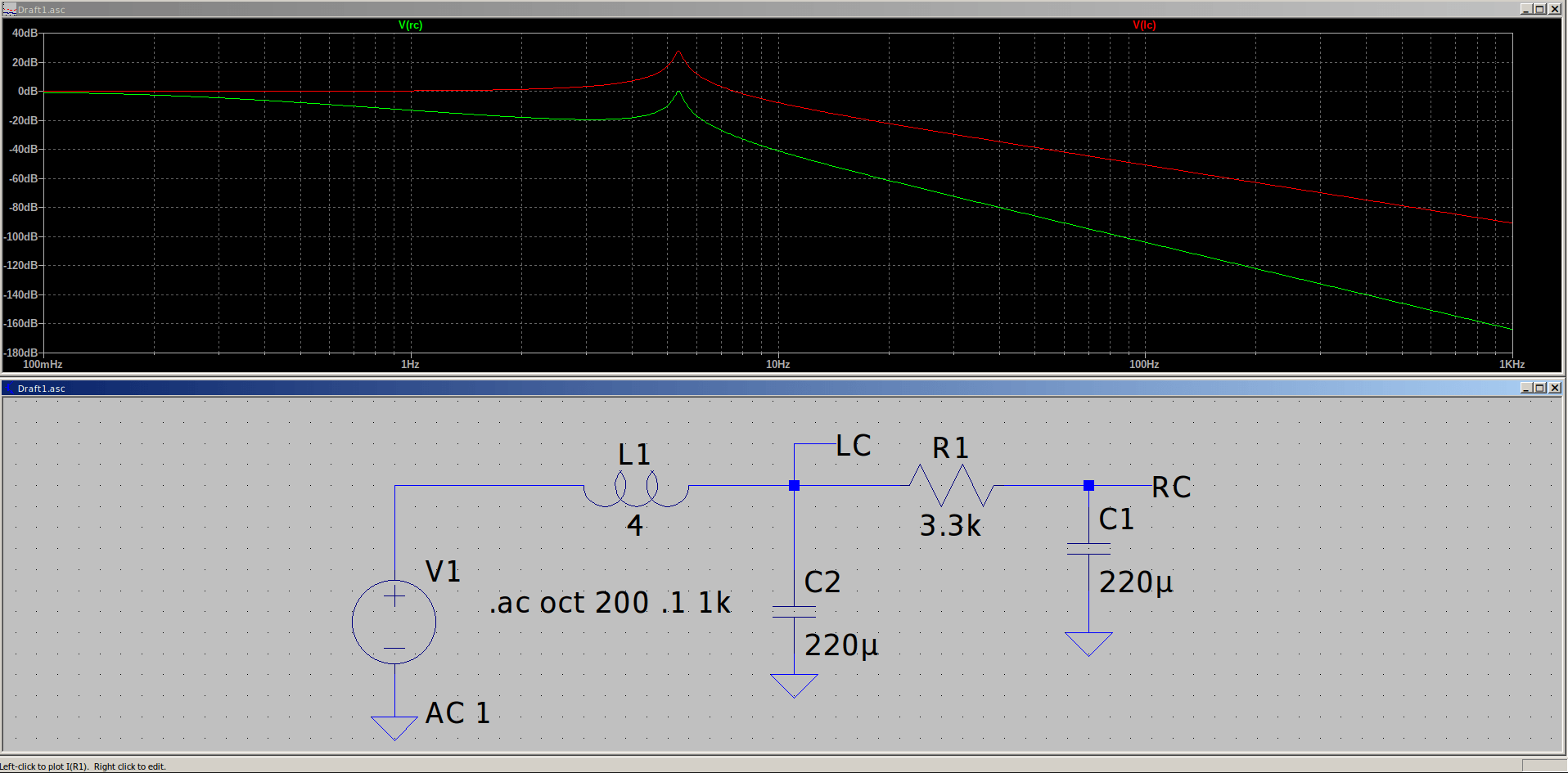

https://edcorusa.com/collections/power-chokes/products/cxse5-5k-4h-50ma-choke
Through setting its series resistance to zero and then the actual 170 ohm value with the former showing a resonant peak which the series resistance damps out. I set a following RC stage with a lower turnover frequency to reduce any resonance. Would a similar approach be the way to compensate for resonances due to other stray parameters in the amplifier circuit or would you need to know the exact kind of resonances? If doing LCLCRC would you want the turnover frequencies of the two LC filters to be different so as not to multiply any resonances?
Attachments
No, they are both preamps. CLCLCis i s a poor design choice for both."preamp" is a line preamp,like aikido is, "phono" is phono 🙂
CLCLC is overkill for line stage, but it is ok for phono
Cheers
Ian
- Home
- Amplifiers
- Tubes / Valves
- CLCLC Power Supply for Aikido octal


